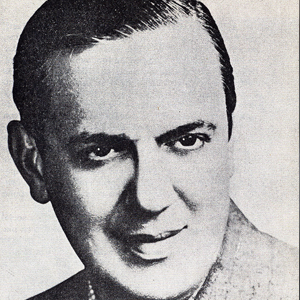Ernesto Lecuona y Casado (August 6, 1895 – November 29, 1963) was a Cuban composer and pianist of worldwide fame. He composed over six hundred pieces, mostly in the Cuban vein, and was a pianist of exceptional skill. His father was Canarian and his mother was Cuban.
Lecuona was born in Guanabacoa, Havana, Cuba. He started studying piano at an early age, under his sister Ernestina Lecuona, a famed composer in her own right. As a child prodigy, he composed his first song at the age of 11. He later studied at the Peyrellade Conservatoire under Antonio Saavedra and the famous Joaquín Nin. Lecuona graduated from the National Conservatory of Havana with a Gold Medal for interpretation when he was sixteen. He performed outside of Cuba at the Aeolian Hall (New York) in 1916.
In 1918 he collaborated with Luis Casas Romero, Moisés Simons, Jaime Prats, Nilo Menéndez and Vicente Lanz in setting up a successful player piano music roll factory in Cuba producing Cuban music and also copies from masters made by QRS in the USA. The brand label was “Rollo Autógrafo”
He first travelled to Spain in 1924 on a concert tour with violinist Marta de la Torre; his successful piano recitals in 1928 at Paris coincided with a rise in interest in Cuban music.
María la O, Lecuona’s zarzuela, premiered in Havana on March 1, 1930. He was a prolific composer of songs and music for stage and film. His works consisted of zarzuela, Afro-Cuban and Cuban rhythms, suites and many songs which are still very famous. They include “Siboney” (Canto Siboney), “Malagueña” and “The Breeze And I” (Andalucía). In 1942, his great hit, “Always in my heart” (Siempre en mi Corazón) was nominated for an Academy Award for Best Song; however, it lost to “White Christmas”. Lecuona was a master of the symphonic form and conducted the Ernesto Lecuona Symphonic Orchestra, employing soloists including Cuban pianist and composer Carmelina Delfín. The Orchestra performed in the Cuban Liberation Day Concert at Carnegie Hall on October 10, 1943. The concert included the world premiere of Lecuona’s Black Rhapsody. Lecuona gave help and the use of his name to the popular touring group, the Lecuona Cuban Boys, though he did not play as a member of the band. He did sometimes play piano solos as the first item on the bill.
In 1960, thoroughly unhappy with Castro’s new régime, Lecuona moved to Tampa, Florida and lived on West Orient Street in West Tampa with his relative, singer Esperanza Chediak. Lecuona lived his final years in the USA, but while traveling in the Canary Islands three years later, he died in the town of Santa Cruz de Tenerife on November 29, 1963 as a result of an attack of asthma, a disorder from which he had suffered his entire life. He was interred at Gate of Heaven Cemetery in Hawthorne, New York, but his will instructs that his remains be repatriated once the current régime runs its course. A great deal of Lecuona’s music was first introduced to mass American audiences by Desi Arnaz, a fellow Cuban and Lucille Ball’s spouse.
Lecuona’s talent for composition has influenced the Latin American world in a way quite similar to George Gershwin in the United States, in his case raising Cuban music to classical status.
Ernesto and Ernestina’s cousin Margarita Lecuona was another accomplished musician and composer. She was the author of the song “Babalú”, made popular in the Latin American world by Miguelito Valdés, and in the United States by Desi Arnaz (who, contrary to popular folklore, did not write the song).
Lecuona was included as a character in the novel The Island of Eternal Love, by Miami-based Cuban writer Daína Chaviano, together with other important names in Cuban music.


10 thoughts on “Kaminos”
Was Nicholas related to Alexander Saslavsky who married Celeste Izolee Todd?
Anyone have a contact email for Yair Klinger or link to score for Ha-Bayta?
wish to have homeland concert video played on the big screen throughout North America.
can organize here in Santa Barbara California.
contacts for this needed and any ideas or suggestions welcomed.
Nat farber is my great grandpa 😊
Are there any movies or photos of max kletter? His wife’s sister was my stepmother, so I’m interested in seeing them and sharing them with his wife’s daughter.
The article says Sheb recorded his last song just 4 days before he died, but does not tell us the name of it. I be curious what it was. I’d like to hear it.
Would anyone happen to know where I can find a copy of the sheet music for a Gil Aldema Choral (SATB) arrangement for Naomi Shemer’s “Sheleg Al Iri”. (Snow on my Village)?
Joseph Smith
Kol Ram Community Choir, NYC
שלום שמעון!
לא שכחתי אותך. עזבתי את ישראל בפברואר 1998 כדי להביא את בני האוטיסט לקבל את העזרה המקצועית שלא הייתה קיימת אז בישראל. זה סיפור מאוד עצוב וטרגי, אבל אני הייתי היחיד עם ביצים שהביא אותו והייתי הורה יחיד בשבילו במשך חמישה חודשים. הוא היה אז בן 9. כעת הוא בן 36 ומתפקד באופן עצמאי. נתתי לו הזדמנות לעתיד נורמלי. בטח, אבות כולם חרא, אומרים הפמינציות, אבל כולם צריכים לעבוד כמטרות במטווחי רובה!
משה קונג
(Maurice King)
Thank you for this wonderful remembrance of Herman Zalis. My late father, Henry Wahrman, was one of his students. Note the correct spelling of his name for future reference. Thank you again for sharing this.
Tirza Wahrman (Mitlak)
amazing zchuso yagein aleinu, he wrote the famous niggun Lefichuch that is sung in almost every Israeli Yeshiva